Prairie Song
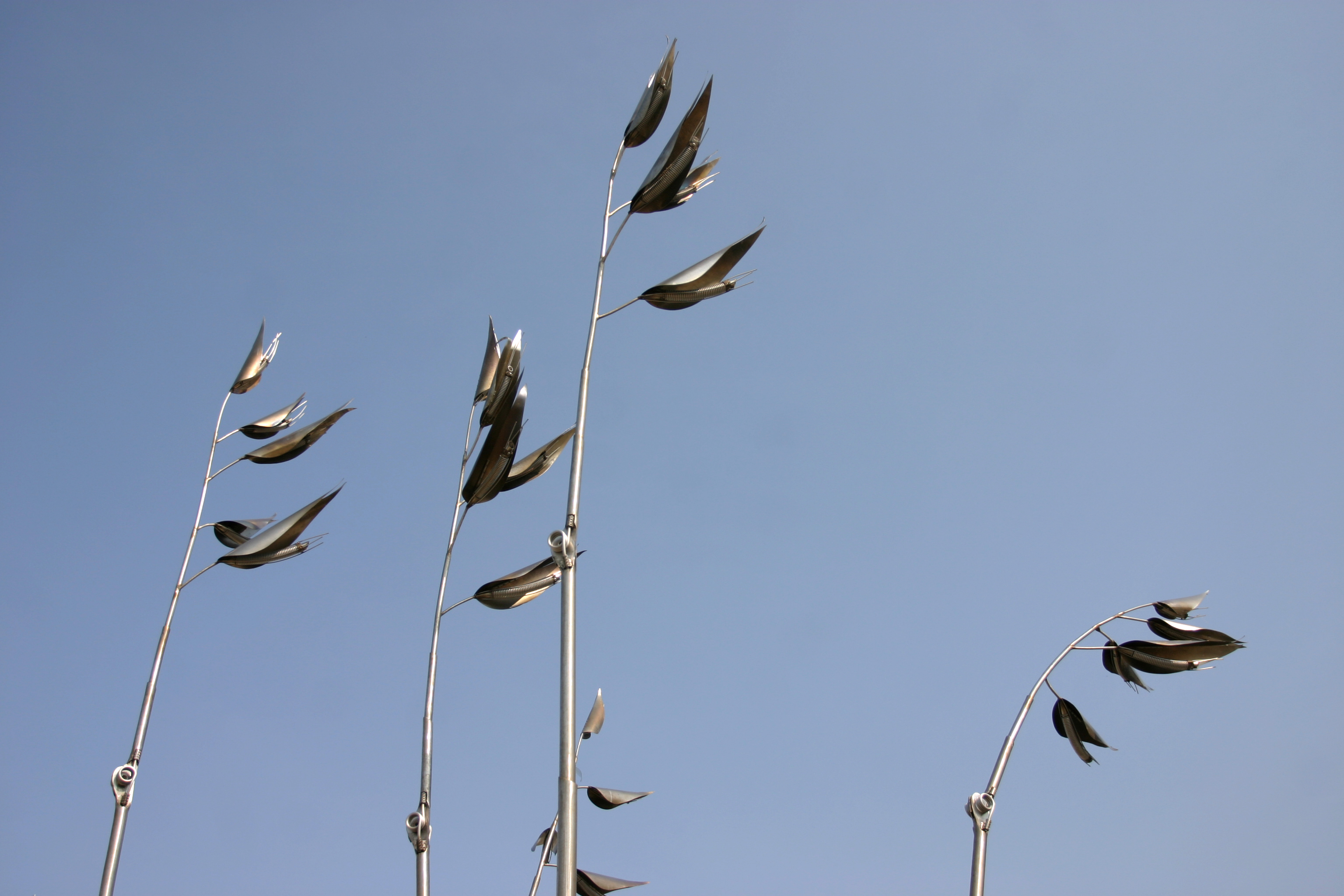
|
This artwork was completed in 2013 and funded by the Art in State Buildings Program. The piece consists of five 20-foot tall blades of prairie grass, made from stainless steel. Each “leaf” encases a corrugated steel tube filled with steel balls that rattle in the wind. |
 |
 |
Mortar
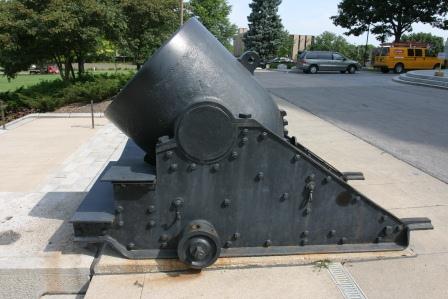
|
Granted to Iowa by an act of Congress, this 13-inch seacoast mortar was shipped from a naval yard in Washington, D.C., in 1895. The 22,000-pound mortar was cast in 1861 at Fort Pitt, Pennsylvania. It was mounted on the North Atlantic Squadron gunboat "Matthew Vassar" and used in the bombardment of Forts St. Phillip and Jackson (1862) and of Vicksburg (1863) during the Civil War. The mortar was given to the state as a reminder of that war. |
 |
 |
Pioneer Statuary Group | Buffalo Fountain
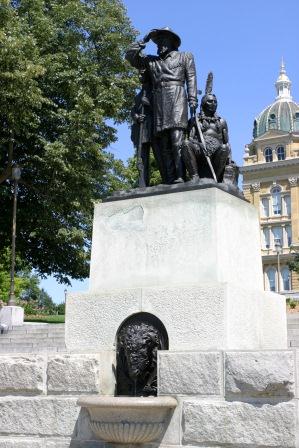
|
In 1884, a committee appointed by Governor Buren R. Sherman chose architect Jacob Weidenmann of New York City to design plans for improving the State Capitol grounds. The plans were set aside while work on the Capitol continued. Six years later, the actual project began, and it was completed in 1892.
The design for this grouping called for: "The Pioneer of the former territory, a group consisting of father and son guided by a friendly Indian in search of a home." The pioneer depicted was to be hardy, capable of overcoming the hardships of territorial days to make Iowa his home. A Connecticut artist, Karl Gerhardt, was contracted to do the piece for $4,500.
Originally designed to be a lion's head, this bronze buffalo head was determined more appropriate to Iowa's prairie environment. The fountain was made for drinking-'for horses as well as humans.
Alexander Doyle, designer of the Great Seal tablet, designed this fountain as well, for $500. |
 |
 |
V.F.W. Monument
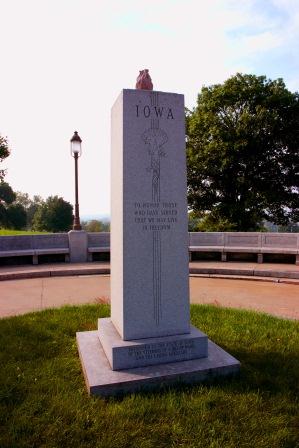
|
A red granite eternal flame burns atop this 10-foot-high white granite memorial. Installed in 1976, it was a Bicentennial gift from Iowa chapters of the Veterans of Foreign Wars and their Ladies Auxiliary to honor all Americans who fought overseas. Dedicated to the state, it was paid for through gifts from V.F.W. posts around Iowa. |
 |
 |
Iowa, A Place to Grow Symbol
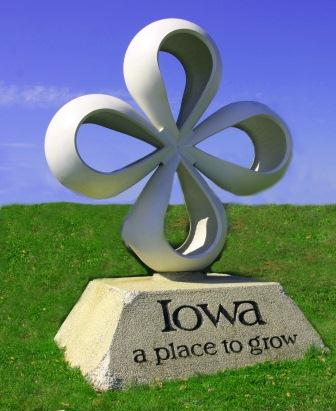
|
The theme "Iowa, a place to grow" and the four-loop symbol were developed in 1970 as a vehicle for all Iowans to use in promoting the state.
Located at East 14th and Grand Avenue (north of the Grimes Building), this symbol represents growth in all directions and strength in unity. In general and on a personal level, it represents economic opportunity for Iowa and individual growth in education, spiritual awareness, friends, and family.
This symbol was de-installed in 2016 by the Iowa Capitol Planning Commission and the Department of Cultural Affairs. It has been placed in the collection of the Iowa Historical Society for historical preservation. |
 |
 |
Mary J. Coggeshall Memorial Marker
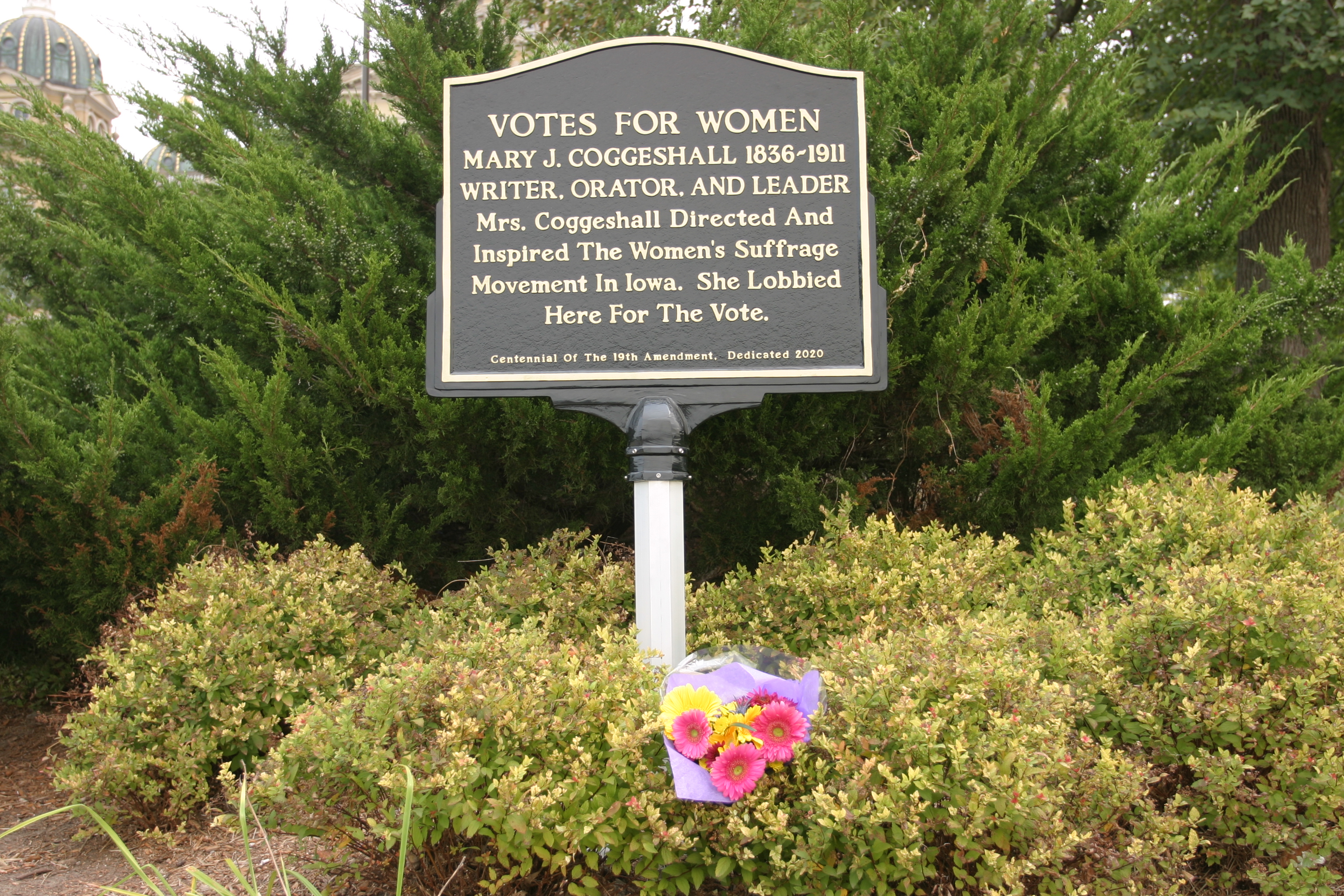
|
The Iowa Capitol Planning Commission, on recommendation from the Site Features Committee, approved the Mary J. Coggeshall Votes for Women Marker. The marker was placed in the flowerbed south of the Pioneer Statuary Group and Buffalo Fountain, which is located west of the Iowa State Capitol, on September 17, 2020. The dedication took place on September 26, 2020. |
 |
 |
West Capitol Terrace Memorial Benches
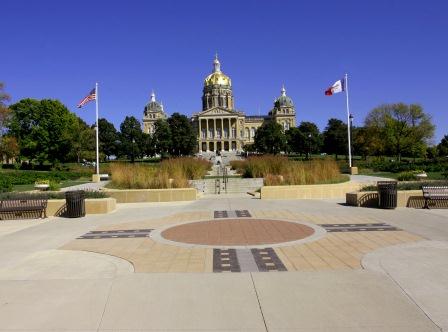
|
Benches honoring the governors of Iowa line the walkways of the Western Terrace.
Parking lots west of the State Capitol were removed during the summer of 2006 to make way for a people's park-the West Capitol Terrace-with pedestrian paths, gathering spaces, benches, and native trees and flowers. |
 |
 |
Five Stones – One Tree Sculpture
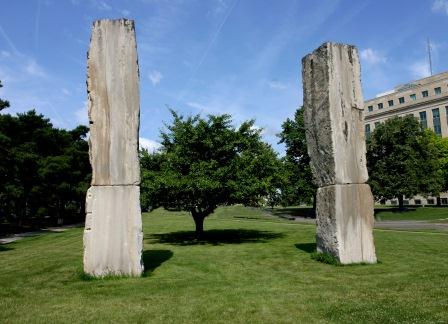
|
In 1974, the Iowa General Assembly determined that one-half of 1 percent of the total cost for both the Hoover and Wallace office buildings would be set aside for artwork to decorate the structures. As part of this program, the National Endowment for the Arts and the state shared the costs for this 1979 monument to the west of the Hoover Building. The $14,000 piece is the work of Iowa City artist Luther Utterback. Five limestone blocks and a Japanese Ginkgo tree are incorporated into the 116-ton work.
Four limestone blocks are arranged above the ground and the fifth stone, a 16-ton block of choice limestone, is buried six feet below the ground. Utterback, who did no polishing or finishing of the stones, commented, "The piece was produced by the earth." |
 |
 |
Submarine Memorial
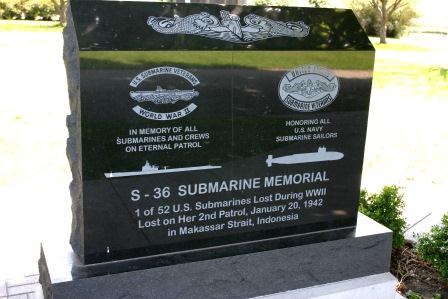
|
The United States Submarine Veterans, Iowa Base, Placoderm Base, proposed construction of a monument on the Capitol Complex as part of a nationwide effort to establish memorials for each of the 52 submarines lost during World War II. The submarine assigned to the Iowa committee for this effort is the S-36. The committee endorsed the concept of such a monument, on the monument grounds south of the Capitol. |
 |
 |
Bicentennial Fountain
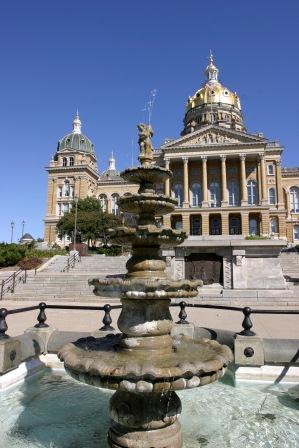
|
A second fountain now stands on the site formerly occupied by the Centennial Fountain. The original, Renaissance-style fountain was a copy of one displayed at Philadelphia's Centennial Exposition in 1876. The ornate cast-iron work was topped with a woman holding a vase. Between its two basins, three additional female figures circled the center support. Swans and cherubs ringed the base.
After decades of vandalism and disrepair, the new fountain was ordered in 1980. The 10-foot-high Bicentennial Fountain was installed in 1982. |
 |
 |
Bryant Boulder
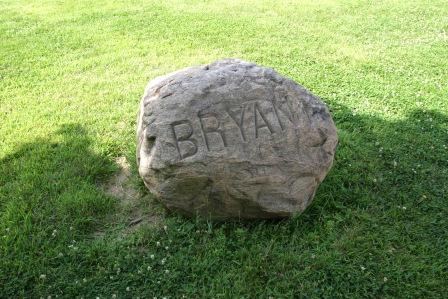
|
This boulder marks the site of Bryant School. The first actual school building on the east side of Des Moines, it was completed in 1867, and named for the American author and poet William Cullen Bryant. Bryant School was acquired by the state in 1917 for $30,000 and used as an office building. The building was condemned in 1936 and ironically served as office space for the State Fire Marshal until it was torn down in 1949. |
 |
 |
Allison Monument
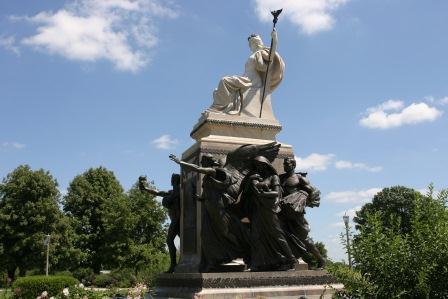
|
In 1917, friends of Senator William B. Allison, citizens and school children of Iowa, and the state Legislature funded this memorial. A pivotal figure in Iowa's Republican party, Allison (1829-1908) represented Iowa in Congress for 43 years. He was twice a candidate for the presidential nomination of his party and was a close associate of every United States president from Abraham Lincoln to Theodore Roosevelt.
Evelyn B. Longman of New York designed the monument, originally a fountain. A central plaque picturing Allison is flanked by symbols of "Knowledge," "Legislature," and "Financial Prosperity" on the left, and "Peace," "Humanity," and "Agricultural Prosperity" on the right. The topmost figure symbolizes "The Republic." |
 |
 |
Cornerstone
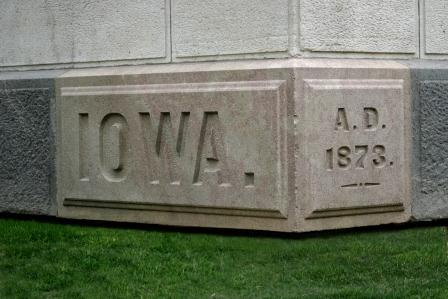
|
The cornerstone is located on the southwest corner of the Capitol. The original cornerstone was laid in November 1871. It was 7 x 3 x 3 feet and inscribed with the names of Capitol commissioners. Inside the cornerstone were 40 items. Weaknesses were found in that first foundation and in 1873 a new commission was formed, a new foundation laid, and the cornerstone re-inscribed. "IOWA. A.D. 1873." is the current inscription. The same 40 items were returned to the cornerstone and another box added that brought the legislative history up to date. |
 |
 |
Daniel Cooper Memorial Tree
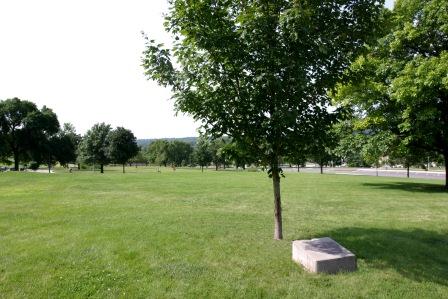
|
The Daniel Cooper Memorial Tree is a sugar maple planted in honor of the horticulturalist.
Daniel Cooper was a long-time secretary/treasurer of the Iowa State Horticultural Society who devoted much of his life to the people involved in the horticulture field. He established a scholarship for students interested in majoring in horticultural science. |
 |
 |
Spanish-American War Cannon
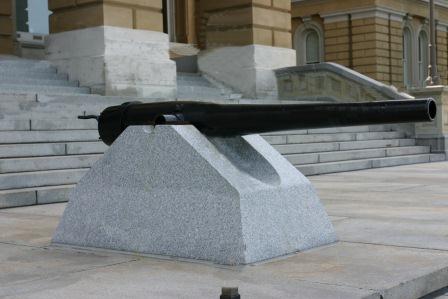
|
The Spanish-American War Trophy Cannon (Bochumer Verein Cannon) heads the west stairway to the Capitol. This 9cm breech-loading rifle, captured in 1898 at the Battle of Santiago, Cuba, was brought to Iowa in 1901 through the efforts of the Kinsman Post, Grand Army of the Republic.
It is difficult to trace the history of this cannon because the serial numbers once engraved around the lip of the cannon have worn away. |
 |
 |
Parrott Rifle
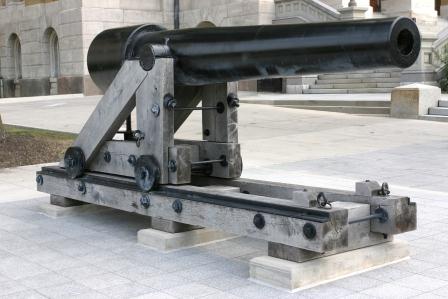
|
The Parrott rifle (No. 167), is a muzzleloading cannon that was cast at West Point Foundry in New York. During the Civil War, No. 167 was part of the armament of the U.S. Steamer "Nipsic." |
 |
 |
Teacher Boulder
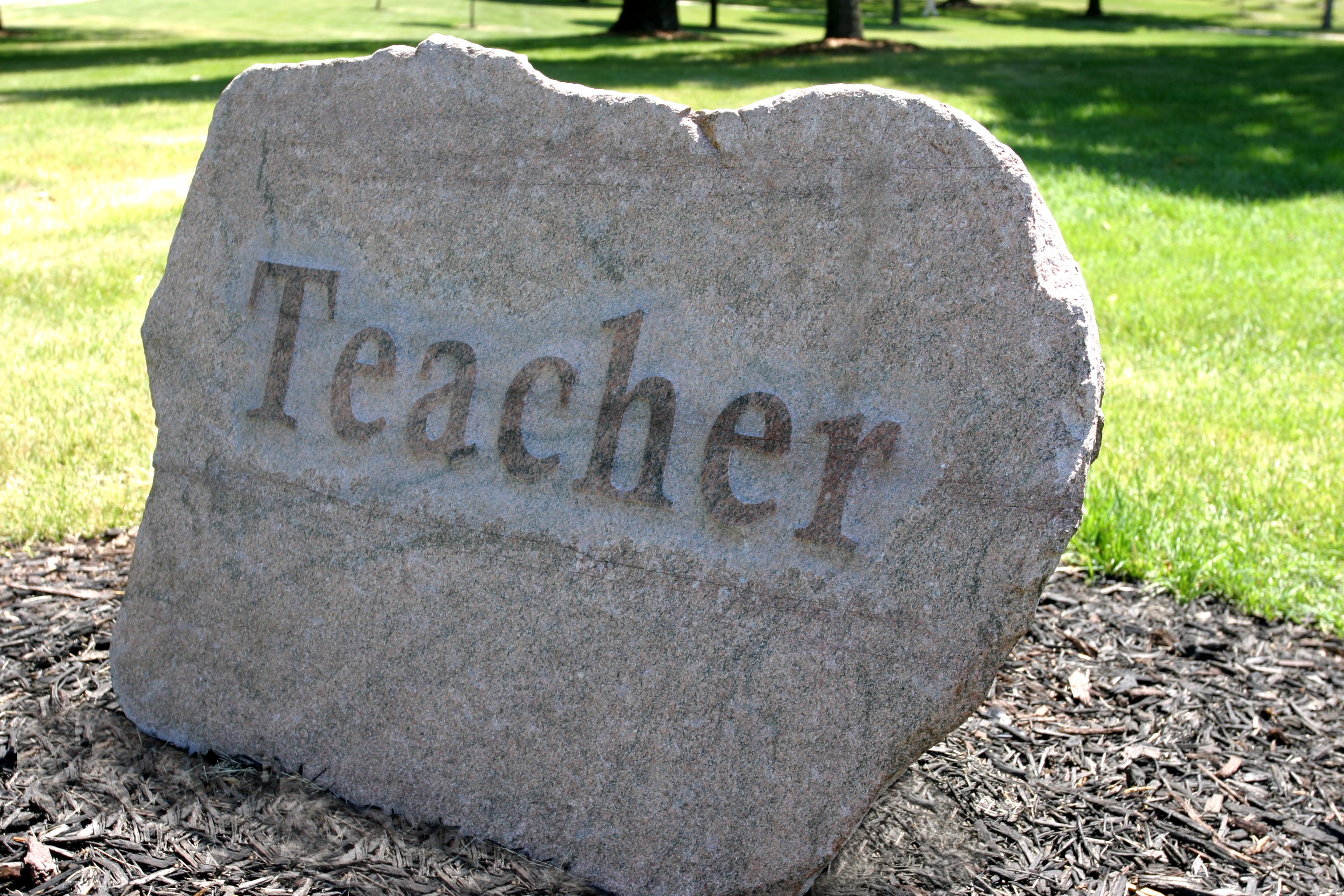
|
The Iowa Teacher Boulder - inspired by the late Steve France, an Iowa teacher and coach - is dedicated to educators who make a difference in the lives of their students. Trucked from Spencer to Des Moines, the boulder weighs approximately 1,700 pounds. The carving on the boulder was done by Fieldstone Graphics in Spirit Lake.
The boulder is located on the grassy area north of the West Capitol Terrace entrance and was provided by the Iowa Association for Health, Physical Education, Recreation and Dance. The monument was officially dedicated on May 6, 2012. |
 |
 |
Bicentennial Time Capsule
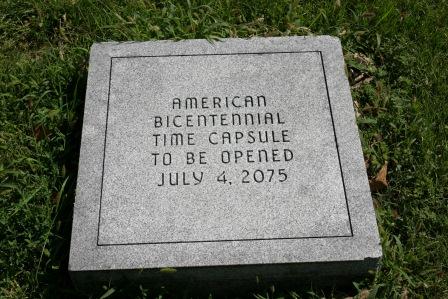
|
Sealed in July 1977 to commemorate the nation's 200th birthday, the time capsule is to be opened on July 4, 2075. There are 59 items in the time capsule which were selected for their historical significance. The capsule holds approximately two cubic feet of materials. |
 |
 |
Centennial Time Capsule
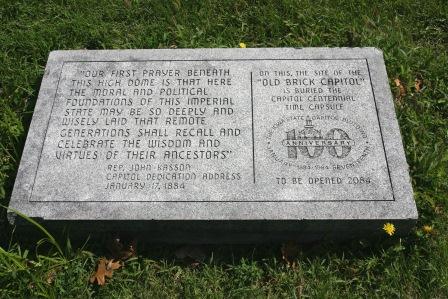
|
The time capsule was filled in 1984 during the 100th anniversary of the dedication of the Capitol. Among items contained in the capsule are a Rubic's cube, a "Where's the Beef?" Wendy's commercial, and income tax forms from 1983. It will be opened January 17, 2084. |
 |
 |
Christopher Columbus Monument
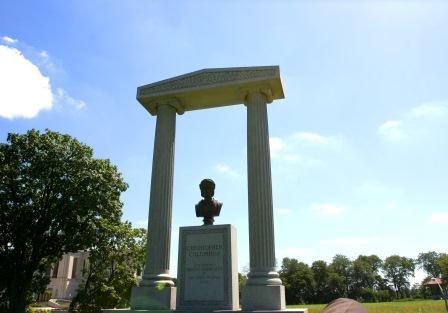
|
The Italian-American community in Iowa donated this monument to the state in 1938. It was financed by individual contributions. A bronze bust of Columbus, the Italian discoverer of America, rests between classical granite pillars. Anthony L. Sarcone, Italian-American publisher and civic leader, coordinated the project for 20 years. |
 |
 |
Crocker Memorial

|
Erected in 1944 by the Crocker Women's Relief Corps, this marker honors the first brigade formed in Iowa during the Civil War. "Crocker's Greyhounds," named for their first commander, General Marcellus M. Crocker, fought at the battles of Shiloh, Iuka, Corinth, Big Shanty, Vicksburg, and Atlanta. The unit marched 8,500 miles during the war. |
 |
 |
Sesquicentennial Tree
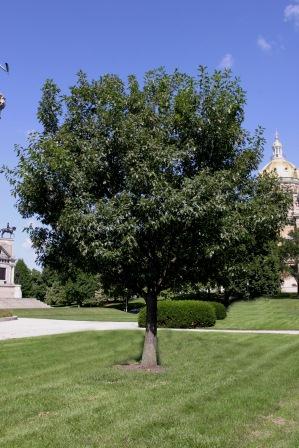
|
A swamp white oak, this tree marks Iowa's sesquicentennial (150 years) 1846-1996. The tree was presented on June 28, 1996, by members of the Iowa Senate and House of Representatives, support staff, lobbyists, the press, and others involved in the legislative process. |
 |
 |
Soldiers' and Sailors' Monument
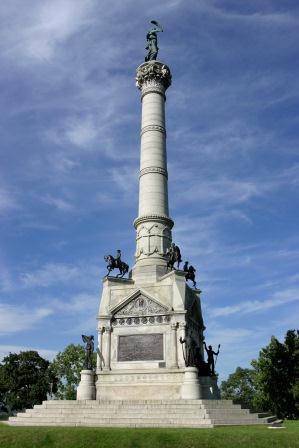
|
The State of Iowa erected this monument, funded partially by refunded war taxes, which commemorates the Iowans who fought during the Civil War. The monument was approved in 1888, the cornerstone was laid in 1894, and the structure was completed two years later. Because a controversy developed over the location and artistic details of the monument, nearly 50 years passed before its dedication in 1945.
Iowa artist Harriet A. Ketcham's design for the memorial was chosen over 47 others, although she died before the monument was completed. Both authentic and symbolic figures are portrayed. "Victory" is the most prominent figure, topping the 135-foot structure. Four equestrians-'all Iowa Civil War generals-'are depicted: Marcellus M. Crocker, who joined Grant at the siege of Vicksburg; Grenville M. Dodge, who built railroads to support Grant's army and accompanied Sherman on the "March to the Sea”; Samuel R. Curtis, commander of the Union Army at Pea Ridge; and John M. Corse, who was promoted to brigadier general in 1863 and assigned to the command of the Fourth Division of the Fifteenth Army Corps.
The four soldiers depicted on the upper base represent Iowans who served in different branches of the military during the Civil War: Infantryman Shelby Norman, who, at the age of 18, was the first Iowan killed in battle; Ensign William H.C. Michael, a school teacher turned sailor; Artilleryman Captain Henry H. Griffiths, whose battery never lost a gun throughout the war; and Cavalryman Lt. James Horton, killed while leading a saber charge at the battle of Lovejoy Station.
Nearly 80,000 Civil War military men were from Iowa, the largest number of soldiers per capita of any state participating during the war. On the east and west sides, noted Iowa generals and battle scenes are pictured along the base. On the north side, a youthful “Mother Iowa” offers nourishment to her children. To the south, "History" gazes into the future, and "Iowa" is portrayed as a youngster. |
 |
 |
Grand Army of the Republic (G.A.R.) Memorial Bench
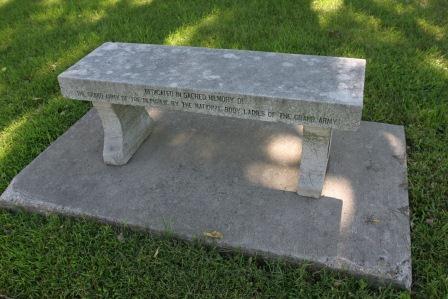
|
The Grand Army of the Republic (G.A.R.) Memorial Bench-made of granite-is located near the G.A.R. Flagpole. The bench was donated by the Ladies of the G.A.R. and presented by Alma C.J. Speckner of Madison, Wisconsin, Patriotic Instructor of the Ladies of the G.A.R. The presentation took place at the 1938 convention in Des Moines. |
 |
 |
Japanese Bell | Bell House
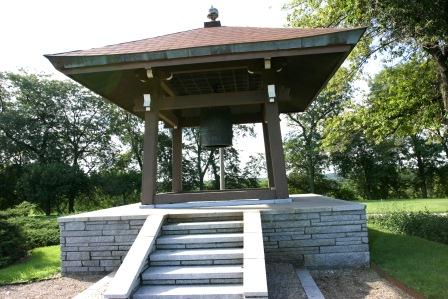
|
After typhoons in 1959 severely damaged crops, homes, and farmlands of the Yamanashi prefecture in Japan, citizens of Iowa generously sent breeding hogs and feed corn to aid that district. This program began a friendship culminating in a sister-state relationship, the first of its kind between the United States and Japan. In 1962, as a sign of their appreciation, the citizens of the Yamanashi area presented this monument to Iowa.
The 2,000-pound temple bell of peace and friendship as well as the structure that houses it, came from Japan. |
 |
 |
Peace Pole
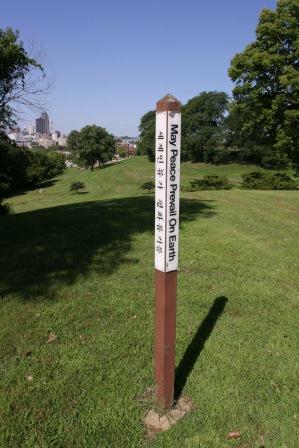
|
The Peace Pole is one of 51 that was presented to all 50 governors and the President of the United States. "May peace prevail on earth" is the message written in four languages. The Peace Pole Project is the official Project of The World Peace Prayer Society. It started in Japan in 1955 in response to the bombings of Hiroshima and Nagasaki. Peace Poles are handcrafted monuments erected the world over as international symbols of peace. |
 |
 |
Scott's Grave
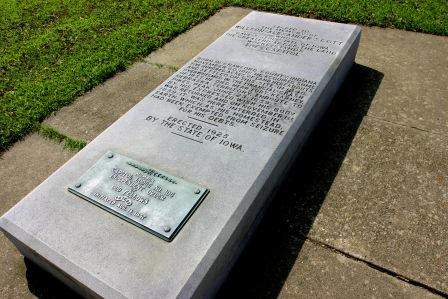
|
Willson Alexander Scott (1818-1859) once told friends: "When I die, I want to be buried here, where I stand..." Years later, Scott's wish was fulfilled, on a bluff overlooking Des Moines. Scott's gravesite is the only burial plot on the State Capitol grounds.
In 1855, Scott and other speculators offered 10 acres of land and promised to build a temporary Capitol if the state chose their side of the Des Moines River for the new State Capitol site. After a fierce struggle between east-side and west-side interests, the state accepted the Scott group's donation.
Scott died four years later en route to Colorado, seeking gold. His friends brought his body back to Des Moines and buried him according to his request. In 1925, the present marker was installed. |
 |
 |
Liberty Bell
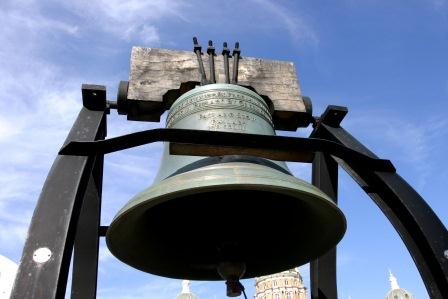
|
The U.S. Department of the Treasury presented the replica Liberty Bell to Iowa in 1950 to thank the state for its efforts in the previous 10 years for war-bond drives.
Governor William Beardsley appropriately dedicated this symbol of independence on Independence Day. The bell, cast in Annery-le-Vieux, France, weighs 2,000 pounds. |
 |
 |
Spanish-American War Monument
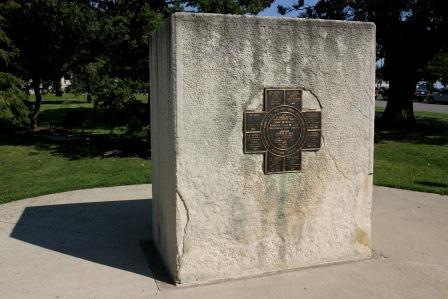
|
The Iowa Volunteer Troops from Camp McKinley raised this memorial to honor Iowans who voluntarily served in the Spanish-American War, the Philippine Insurrection, and the China Relief Expedition. A bronze cross fronts the large granite marker, listing each Iowa regiment that fought in the engagements from 1898 to 1902. Governor Leslie P. Shaw, Iowa's governor from 1898-1902, is also honored. |
 |
 |
Statue of Liberty
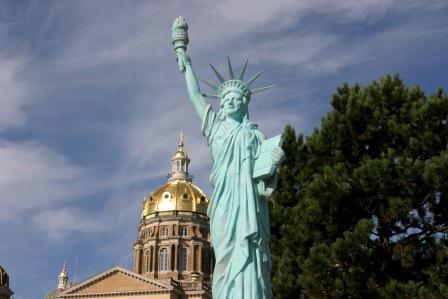
|
In 1950, the Tall Corn (now Mid-Iowa) Council of the Boy Scouts of America donated this miniature Statue of Liberty to the State of Iowa as part of their annual service project. The statue was provided by Jack Whitaker, a Kansas City businessman active in the Boy Scouts at that time. |
 |
 |
Iowa Peace Officer Memorial
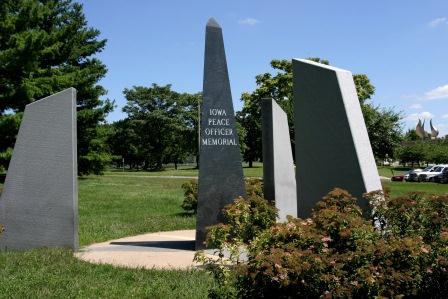
|
This site was selected as the location for a monument honoring Iowa's peace officers. Officer Richard Webb of the Ames Police Department won a statewide competition with the design for this monument. The three individual forms represent the three levels of law enforcement in Iowa (city, county, and state). The forms unite in a center pinnacle expressing the ultimate sacrifice of peace officers that have died while protecting the safety of Iowa citizens. |
 |
 |
Korean War Memorial
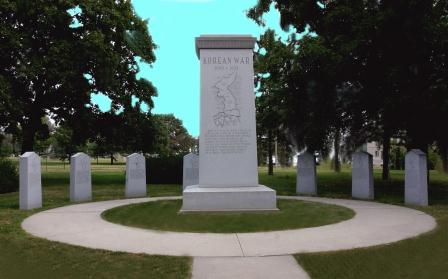
|
The drive for a Korean War monument began in November 1984, when students from a Harding Junior High School class in Des Moines wrote the governor, asking why Korean War veterans did not have a memorial.
The monument, erected on a grassy area south of the Capitol, includes a 14-foot-tall central obelisk and eight 6-foot-tall tablets which tell the story of the Korean War utilizing words, pictures, and maps of Korea engraved in granite. The monument was dedicated by Governor Terry Branstad on May 28, 1989. |
 |
 |
Memorial Plaza (World War II)
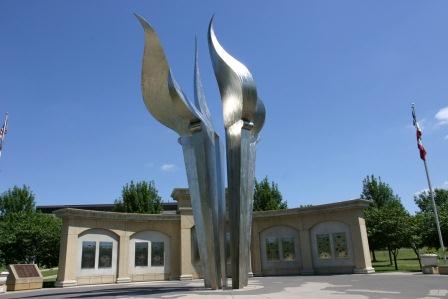
|
Dedicated in November 1997, the purpose of this memorial is to honor all those who served so valiantly during World War II and to provide posterity with knowledge about the compelling reason for the involvement of the United States in the war: "The preservation of freedom around the world." The centerpiece of the "Freedom Flame" monument is a 50-foot-high stainless steel stylized flame. Leading up to the flame is "Freedom Walk," a walkway through time, beginning with Pearl Harbor. The plaza floor is comprised of a global map showing the five major theaters of operation. The "Wall of Memories" is an appropriate backdrop for the Freedom Flame. The total cost of this monument was $735,000-a sum which includes a fund to ensure the memorial's future maintenance.
Incorporated in the World War II Memorial Plaza is the Pearl Harbor Memorial. The Iowa Pearl Harbor Veterans' Association formed a committee to erect a memorial on the grounds of the Capitol in honor of Iowans who made the supreme sacrifice during the attack on Pearl Harbor on December 7, 1941, and in honor of the survivors of the attack. The committee requested permission to place a memorial on the grounds in January 1991, and was able to raise the funds and erect the memorial. It was dedicated on Veterans Day, November 11, 1991. |
 |
 |
Martin Luther King Jr. Tree
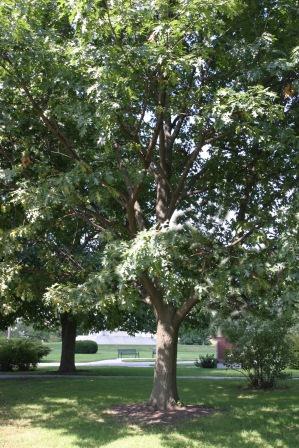
|
The tree, a scarlet oak, was planted in 1984 in memory of Martin Luther King, Jr. Mrs. King asked each of the states to memorialize her husband. Almo Hawkins and Wesley Chapman, both Des Moines citizens, purchased the marker for the tree. |
 |
 |
Purple Heart Combat Veterans Memorial
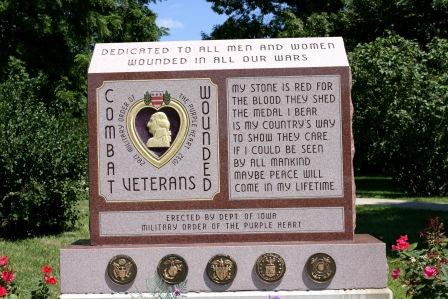
|
The Purple Heart is awarded to members of the armed forces of the United States who are wounded by an instrument of war in the hands of the enemy and posthumously to the next of kin. It is specifically a combat decoration.
This monument was erected by the Department of Iowa Military Order of the Purple Heart and dedicated on February 21, 2004. |
 |
 |
Vietnam War Memorial
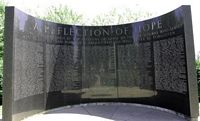
|
The Iowa Vietnam War Monument is similar in design to the national memorial in Washington, D.C. The Iowa Vietnam Commission and Jacqueline Day from Des Moines, whose son was seriously wounded in Vietnam, were able to raise over $85,000 for the project. Day was a former secretary to Governor Norman Erbe and former receptionist for Governor Robert Ray.
The monument was dedicated on Memorial Day, 1984. At a separate ceremony on Veterans Day, November 11, 1984, bronze plaques and missing names were added. |
 |
 |
Memorial Bench
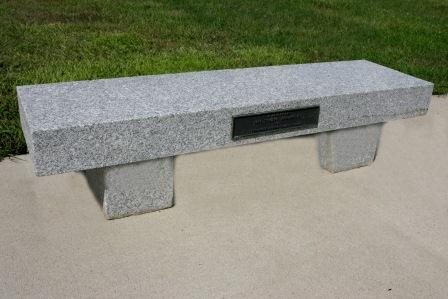
|
Members of the Federated Garden Clubs of Iowa donated funds to purchase the bench in memory of Mrs. Tomoko Yamamoto, noted Japanese flower arranger and instructor. It was dedicated on May 20, 1967, during the formal visit of the Japanese governor to the Iowa Capitol. |
 |
 |
Shattering Silence Monument
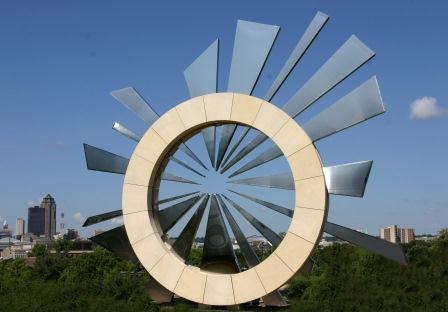
|
"Ralph" was a slave in Missouri, owned by a man named Montgomery. In 1834, Ralph entered into a written agreement with Montgomery to earn his freedom. The agreement allowed Ralph to live in the Iowa territory to earn money to buy his freedom for $550 plus interest. Ralph hoped to earn the money by working in the lead mines near Dubuque. However, after five years he couldn't earn enough money to make the payments.
Two bounty hunters heard about Ralph and offered to seize and return him to Montgomery for $100. Calling him a fugitive from justice, they secured a court order to have the sheriff seize him. They intended to take him by a steamboat back to Missouri. But an Iowa farmer named Alexander Butterworth-'described by a judge as a "noble-hearted Irishman"-'learned of the action and went to the judge, Thomas Wilson.
Judge Wilson stopped the men from returning Ralph to Missouri and suggested the matter should be heard by the Supreme Court of the Territory. Iowa's high court justices heard the case, and on July 4, 1839, they ruled in Ralph's favor. In their ruling the justices stated that Ralph should pay his debt, but contended that "no man in this territory can be reduced to slavery." The justices said because Montgomery allowed Ralph to leave Missouri, and live in a free territory, Montgomery lost his right over him in the Iowa territory.
In their opinion, the justices wrote, "When, in seeking to accomplish his object, (the claimant) illegally restrains a human being of his liberty, it is proper that the laws, which should extend equal protection to men of all colors and conditions, should intervene.”
The unanimous ruling established the tradition in Iowa's courts of ensuring the rights and liberties of all the people of the state. Years later, the Legislature adopted Iowa's motto-'"Our liberties we prize and our rights we will maintain"-'which stands as a permanent reminder that the freedoms in this state are freedoms for all. |
 |
 |
The Pinnacle Monument
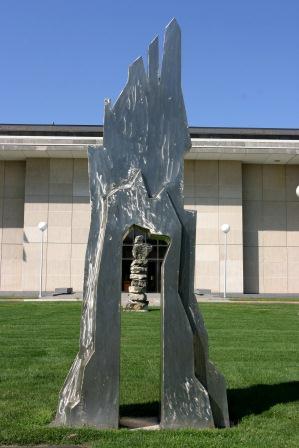
|
This piece was created by Marc Moulton and celebrates Iowa's ethnic heritage. It was commissioned by the Civil Rights Commission and funded in part by the Iowa Arts Council. |
 |
 |
Spanish Howitzer
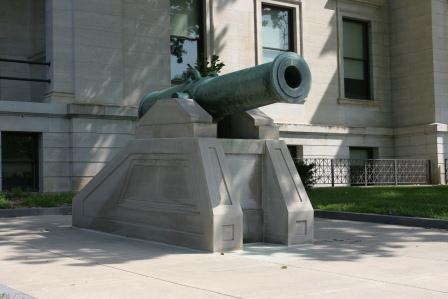
|
This relic of the Spanish-American War was given to the state in 1900 by the United States Department of the Navy. The bronze trophy gun came from the "Maria Theresa," a Cuban ship sunk by the second USS Iowa at the Battle of Santiago. The cannon was taken from Estrella Battery, the shore defenses at Santiago de Cuba. The muzzleloader has a smooth eight-inch bore. |
 |
 |
Workers’ Monument
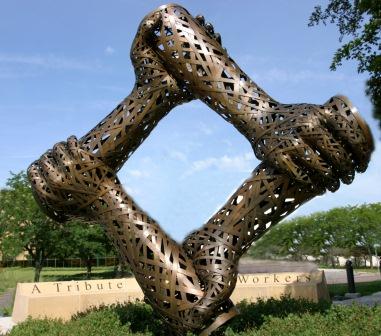
|
Iowa is the 38th state to create a monument to its workers. The initial originators of the idea of a Workers Monument felt strongly that the proper credit be given to the Iowa workers' strong work ethic, which contributes to making Iowa a great place to live and work. This 11-foot tall by 11-foot wide balanced square form is four interlocking arms and hands, a powerful universal image, dedicated to the energy and integrity of the Workers of Iowa. Each arm supports the other, in the same way a diverse blend of people, from many backgrounds, come together to work and create the cultural and business base of Iowa. Built of welded bronze strips, supported by a stainless steel interior armature, the sculpture combines twisting, woven, fluidity with a bundled energy that recalls muscles and nerves and their potential for movement and feeling. The open, latticed quality of the construction allows sunlight to sparkle and dance through the sculptural space, shifting constantly between the internal and external realms. Bronze's reflective depth, warm earth tones, and its aging patina have textural richness and exceptional durability. |
 |
 |
Grand Army of the Republic (G.A.R.) Memorial Tree
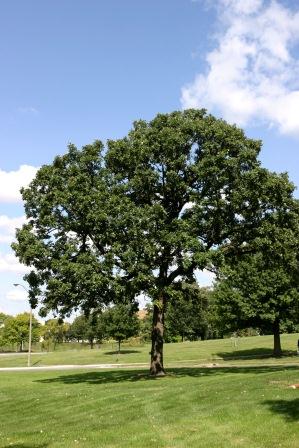
|
In 1866, veterans of the Union forces formed an organization called the Grand Army of the Republic (G.A.R.). Over the next 80 years, the G.A.R. met annually in both state and national encampments. The National Women's Relief Corps, an auxiliary of the G.A.R., planted this tree in honor of the Civil War veterans during a national encampment in Des Moines. |
 |
 |
Revolutionary War Memorial
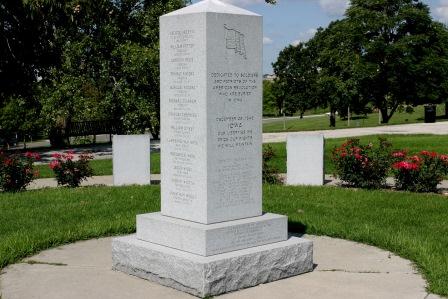
|
This monument, presented by the Iowa Society of the Sons of the American Revolution, features a central obelisk inscribed with the names of 39 Revolutionary War veterans who are buried in Iowa. It is surrounded by 13 granite pillars with patriotic quotations dedicated to the original colonies. Between the pillars are planted wild roses, Iowa's state flower. |
 |
 |
Grand Army of the Republic (G.A.R.) Flagpole
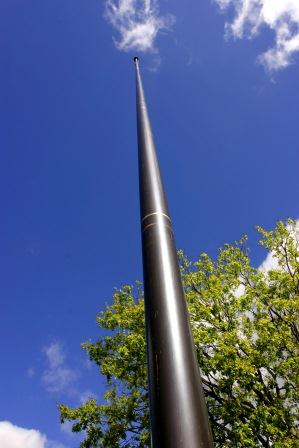
|
The 65-foot pole was dedicated to the memory of the Grand Army of the Republic (G.A.R.) and was donated to the state by the Ladies of the Grand Army of the Republic during the 1931 65th National Encampment of the G.A.R. On one side of the base is a bronze engraving of Abraham Lincoln; on the other side an eagle, the Union Army symbol, is pictured. |
 |
 |
Oley Nelson Tree
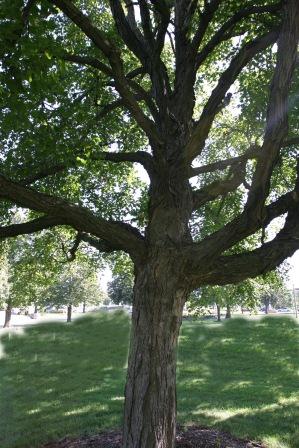
|
Donated by the Iowa Sons of Union Veterans at the June encampment in 1936.
Nelson was the commander-and-chief of the Grand Army of the Republic (G.A.R.) from 1935 to 1936, and served as a representative during the 21st and 22nd General Assemblies. He also served as a sergeant-at-arms in the House of Representatives from 1923 to 1937. A photograph of Oley Nelson hangs in the House Chamber. |
 |
 |
Cosmic Seed Sculpture
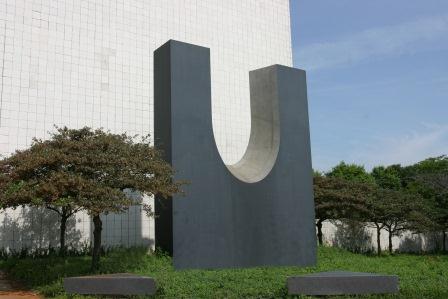
|
The black, stainless steel structure in front of the Wallace Building is the creation of Ronald Bladen of New York City. Bladen, a noted minimalist, was chosen to design a monument complementing the new State Agricultural Building. Funding for the $60,000 project came from the National Endowment for the Arts and the state, under the same legislation that financed Utterback's "Five Stones — One Tree."
Bladen worked for three years on the 17,000-pound, 24-foot-high and 20-foot-wide sculpture. He described its relationship to agriculture as philosophical rather than direct; a simple statement of the basic and solid importance of agriculture to Iowans and all peoples throughout the world. |
 |
 |
Soldiers in White Memorial
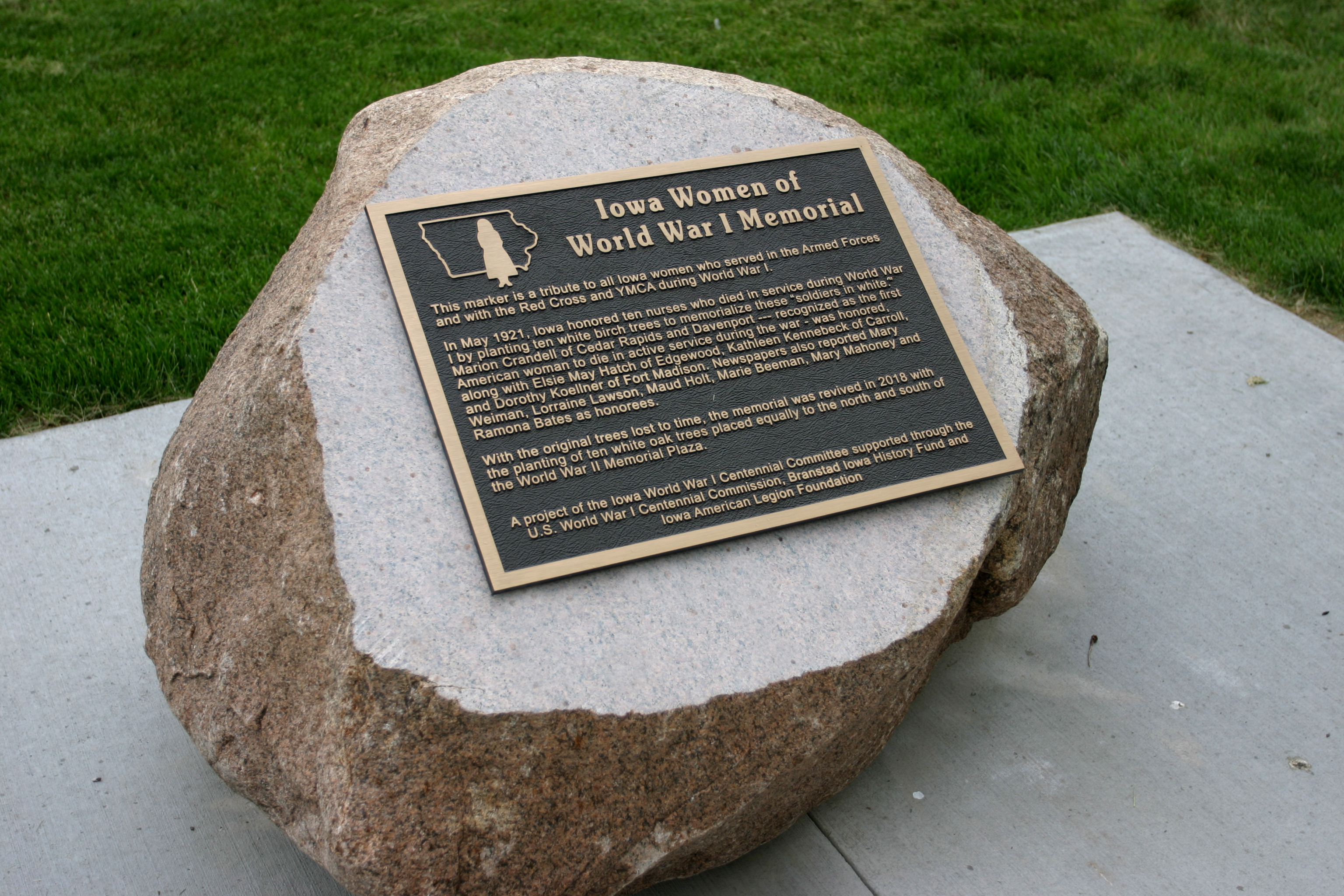
|
The Soldiers in White memorial was a tribute to the 10 Iowa nurses who lost their lives during the war. The memorial included 11 white birch trees planted somewhere on the Capitol grounds. There were 10 trees planted for the Iowa nurses, and the 11th was named for Jane Delano, who was credited with organizing more than 36,000 nurses nationwide. |
 |
 |
Grand Army of the Republic (G.A.R.) Sundial
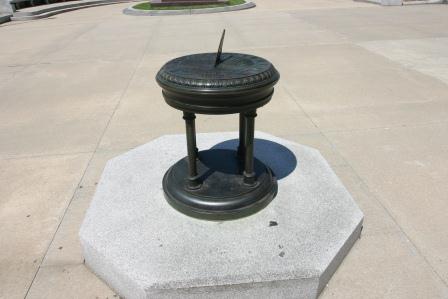
|
This bronze sundial was dedicated to Union veterans of the Civil War during their 1938 Grand Army of the Republic (G.A.R.) encampment in Des Moines. Of the nearly three million Union soldiers who fought during the Civil War, only an estimated 5,000 were still living in 1938, and more than 100 of these veterans attended this 72nd encampment. Most were over 90 years old.
Dr. D. W. Morehouse, then president of Drake University and astronomy professor, installed and adjusted the timepiece. |
 |
 |
Great Seal of Iowa
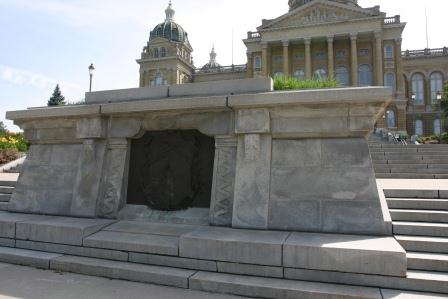
|
This bronze tablet is a near-replica of the state seal used by Iowa governors. An eagle holds a banner proclaiming the state motto: Our liberties we prize and our rights we will maintain.
Below, a soldier stands with gun and liberty cap in hand, the plow not far away. In the background is the steamer "Iowa" on the Mississippi River. Just behind it, a furnace and smokestack represent the lead factories at Dubuque.
Alexander Doyle of New York City was paid $650 to design the tablet. |
 |
 |
Holocaust Memorial
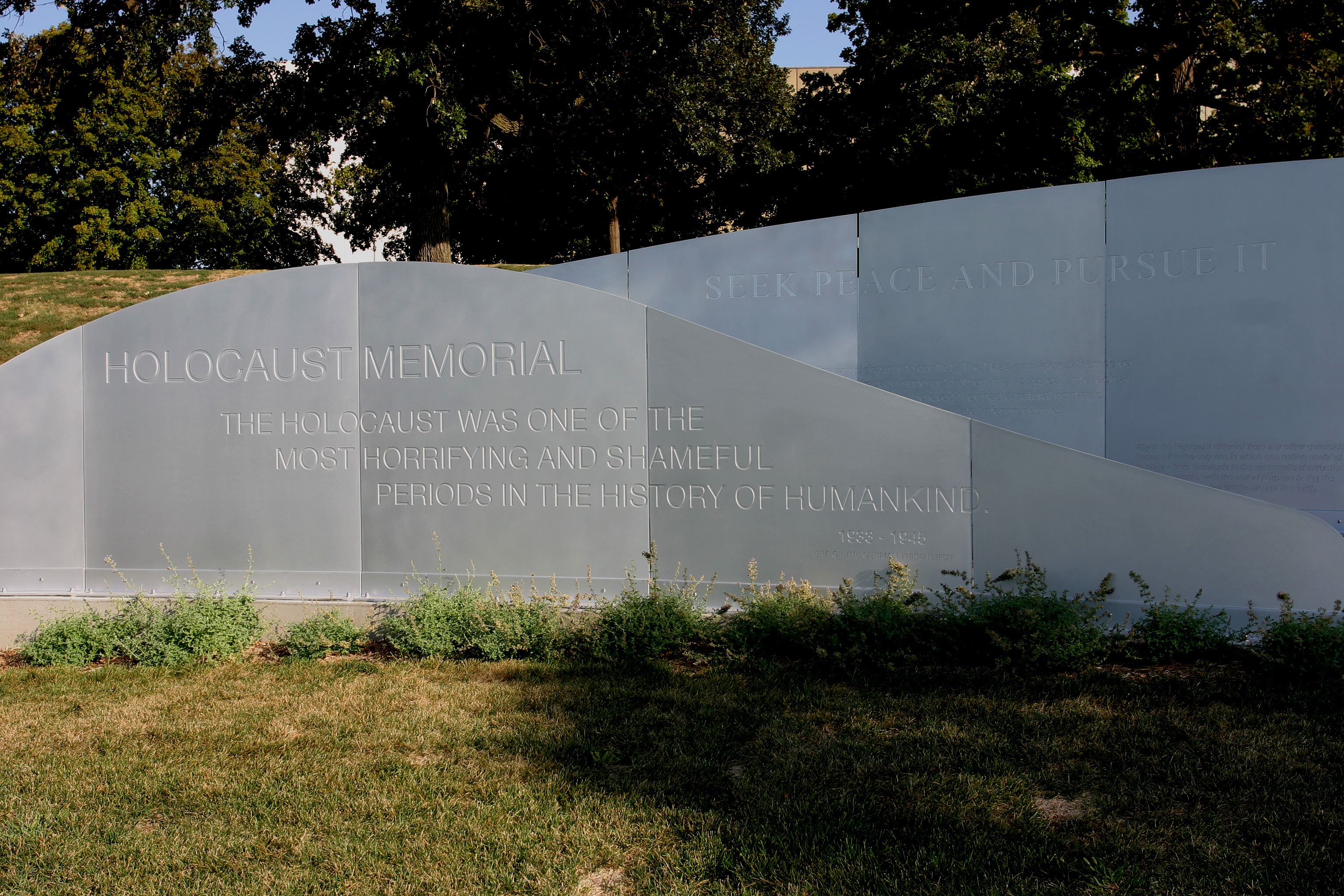
|
The Holocaust Memorial was installed on the West Capitol Terrace in June 2013. The design of ribbons of aluminum in concrete, with prairie grasses, is intended to be an abstract representation of a Holocaust survivor's journey. The struggle for survival and perseverance in the face of oppression are described in text samples along the memorial.
As the visitor moves east, the rolling features of the landscape blossom and expand outward to the State Capitol, showcasing Iowa's role as a welcoming refuge for any people in need of a new start. |
 |
 |
Lincoln And Tad Statue
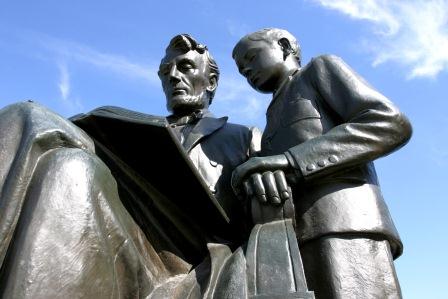
|
Sculpted by Fred and Mabel Torey of Des Moines, the statue was dedicated on the anniversary of the Gettysburg Address, November 19, 1961. The Lincolns had four sons. Tad (named for Lincoln's father) died at age 18. The $25,000 cost of the monument was raised primarily by Iowa school children and a booth at the Iowa State Fair. |
 |
 |






















































































































































 Permanent Link
Permanent Link